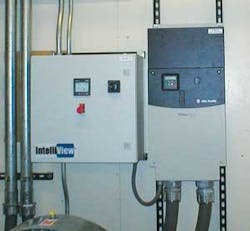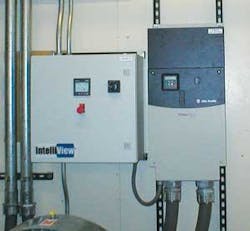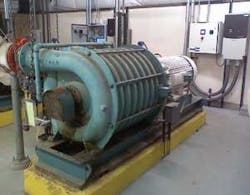New Aeration Control System Offers Energy Savings
By Tom Jenkins
The rising cost of energy and increased concern about sustainability has caused many wastewater treatment facilities to implement energy cost reduction programs. Aeration is the largest single user of energy in a typical wastewater treatment plant. This means the aeration process should be evaluated when implementing energy reduction programs.
In order to maintain an aerobic biological process it is necessary to maintain the appropriate dissolved oxygen (DO) concentration in the basin. Inadequate DO can result in poor treatment, but excess DO wastes energy without improving treatment. Control of the DO concentration is generally the most cost effective method of optimizing aeration energy. A properly operating DO and aeration control system can save 25% to 40% of the energy used by manually controlled systems.
A successful control system design must integrate the process requirements at the basins, the distribution of air flow between basins, and control of the blowers providing the air flow. A variety of parameters must be incorporated into the control logic for each portion of the process. Mixing limitations, flow control valve characteristics, and safe blower operating ranges are just a few of the necessary considerations.
The intricate relationships between control parameters explain why many DO control systems fail to provide the expected benefits. A system design based on conventional control strategies and simple off the shelf hardware may not adequately accommodate the complexity of the aeration process.
One of the characteristics of DO control is the extreme non-linearity of the process response. This, combined with slow process reaction rates and significant transport delays, makes it difficult to achieve stable control with conventional Proportional-Integral-Derivative (PID) algorithms while remaining responsive to demand changes.
An example of a control system specifically developed for aeration process control is the advanced IntelliView® recently introduced by Dresser Roots. The system will be on display at WEFTEC ‘09. It consists of a family of scalable and modular application specific controllers developed for aeration and blower control.
Three recent applications of this system, one at a food processing plant and two at municipal wastewater treatment facilities, illustrate the installation economies and energy savings achievable with this type of application-specific system design. The advanced systems at these facilities employ a control algorithm that was specifically developed for DO control. The result is the ability to hold DO within ±0.25 ppm during process variations.
In most aeration control systems, changes in basin DO concentration are used to adjust flow control valves for each basin or control zone. Historically, blower control systems have relied on maintaining constant pressure to minimize the impact of control valve adjustments on adjacent basins. The pressure control loop was also used to pace the blowers when demand changes at the tank caused the basin control valves to modulate.
Because blower power consumption is proportional to both flow rate and discharge pressure, incorrect adjustment of the pressure setpoint leads to wasted power. The additional control logic required to implement pressure control can also lead to stability issues in blower and aeration control. Using the capabilities of modern controllers, systems designed specifically for aeration control can control air flow at the basins and the blowers without pressure loops. This eliminates the complexity, tuning, and potential hunting issues associated with pressure control based systems.
The energy advantage of eliminating excess system pressure has led to the development of Most-Open-Valve (MOV) logic. The purpose of MOV is to keep some basin flow control valves in a maximum position at all times, minimizing restriction and pressure drop. In traditional systems MOV functions through manipulation of the pressure setpoint, which induces additional tuning complexity and potential instability. By eliminating pressure control the advanced systems directly manipulate basin flow control valves. This provides more accurate and robust power optimization than systems based on general purpose hardware and generic logic.
Many facilities are exploring reducing operating costs by applying aeration controls to existing aeration and blower systems. A number of techniques useful in accomplishing retrofit installations at the lowest possible cost were implemented in the three installations. These include:
- Using communications for VFD control instead of hardwired signals. This also allows more detailed information on VFD and blower performance to be displayed on the controller touchscreen.
- Incorporating air flow calculated from blower performance characteristics and measured power, pressures and temperatures. This permits implementation of advanced control and blower protection logic in applications where piping constraints do not accommodate the installation of a flow meter for each blower.
- Elimination of 4-20 mA valve position control, instead using direct control of a motor operated valve for control. With this technique existing valve operators can be used for modulating air flow without upgrading the operator to more expensive analog control.
- Providing communications ports and data register information at the master controller. This encourages connection to existing plant SCADA applications for performance monitoring and tuning.
Wastewater treatment operators are increasingly faced with reducing operating budgets and meeting management directives to increase sustainability. Reduction of aeration energy is an essential part of satisfying both of these requirements. Incorporating advanced aeration controls, with strategies and hardware specifically developed for optimizing the aeration process provides a cost effective way to upgrade existing facilities. WW
About the Author:
Thomas E. Jenkins, P.E. is Chief Design Engineer of the Dresser Roots Wastewater Solutions Group. He has been involved in energy management and aeration system optimization for over 30 years.
Dresser is an exhibitor at the WEFTEC.09 event and can be found at Booth No. 4818


